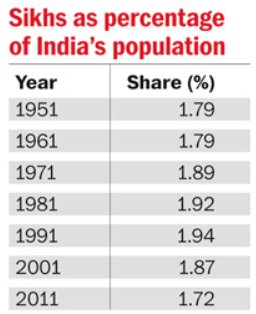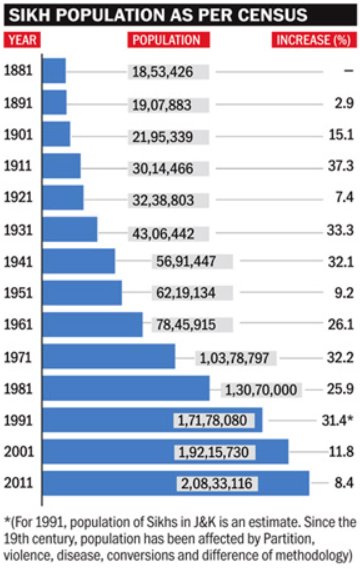Saying that the population of Sikhs has declined in the country is a misreading of the Census by religion. It is the rate of population growth that’s come down. In the larger national goal of population control, Sikhs could rightfully see themselves as being flag-bearers of this wise cause

First, the denial. The Sikh population is not on the decline, an impression that has gained ground as a result of wrong interpretation and reading of the 2011 Census data released on the Indian population by religion. Between 2001 and 2011, the number of Sikhs in India increased by 8.4 per cent.
 What has got various sections of the community, especially politicians, so anxious and agitated is the fact that the rate of growth of the Sikh population has slowed down from 11.8 per cent in the period 1991-2001 to 8.4 per cent from 2001-2011. As many other communities have gained relatively fewer privileges that lead to the progressive trend of birth control, their rate of growth has not come down by as much. Consequently, the share of the Sikh population in the national total has come down from 1.9 per cent to 1.7. What needs to be realised is that while every community has been successful in controlling growth, some have recorded greater success.
What has got various sections of the community, especially politicians, so anxious and agitated is the fact that the rate of growth of the Sikh population has slowed down from 11.8 per cent in the period 1991-2001 to 8.4 per cent from 2001-2011. As many other communities have gained relatively fewer privileges that lead to the progressive trend of birth control, their rate of growth has not come down by as much. Consequently, the share of the Sikh population in the national total has come down from 1.9 per cent to 1.7. What needs to be realised is that while every community has been successful in controlling growth, some have recorded greater success.
The reactions of some of the prominent people who have taken it upon themselves to represent or lead the Sikh community are shocking. Akal Takht Jathedar Gurbachan Singh has repeated his earlier call to fertility, asking for couples to produce four children. SAD MP Prem Singh Chandumajra has seconded the idea, saying it needs to be made the norm. The Shiromani Gurdwara Parbandhak Committee (SGPC) has been urged to take steps in this regard.
The SGPC chief, Avtar Singh Makkar, however, has been more circumspect, even honest. He says the size of the Sikh population has political implications. He has perhaps hit the nail on the head — so that’s what it is about! Not social development, or even religious adherence, but the votes. Just as all of the country’s politics is engineered on caste and religion vectors, Punjab has the Sikh population at the heart of its calculations.
The concerns
Several phenomena have been cited as points of worry by the Sikh leadership. These deserve to be examined individually.
Emigration of Sikhs: This community was among the first to make use of employment opportunities in all lands where the ‘British sun’ shone. The pace of migration has seen a spike in the decade under consideration. Sikh population in just England and Wales increased by 26 per cent between 2001 and 2011. Should this be a cause for worry for the Sikhs ‘back home’? The success and the increase in recognition the community is gaining by the day across the world should, if anything, be a matter of pride. The remunerations they send to Punjab a matter of glee, most of all for political parties that make a beeline for the NRI donor before elections. Anyway, such migration only frees up resources for the remaining population in Punjab.

Conversion: The insular and rigid outlook of modern Sikh leadership — as opposed to the founders’ idea — has led to many castes with small numbers being either pushed out or not included despite their wanting to. A subsequent spurt of deras or increase of other religions’ numbers is now bothering the Sikh leaders. The fear is the medicine should not be worse than the disease. Taking up a confrontationist attitude — of which there has been evidence in recent years — can only make matters worse.
Sex ratio: This is the one and only real cause of worry. Among Sikhs, there are only 903 women per 1,000 men, the worst ratio among all religions. That means a poorer social health for the community, which will have economic implications as well. The motives for this ironically are the same that keep the population down — material interest. Economic security is a major factor in lower fertility rate, which is an average of 3.1 children per woman among Sikhs, against a national average of 3.8. And the preference for a male child also has roots in a misplaced notion of securing family assets. The voice of the leadership has been less than audible on this crucial reform.
All the reasons that have led to better reining in of the population growth among Sikhs are something to be proud of. Relatively a higher level of education among their women is one. Acceptance of modern concepts of birth control, awareness of the benefits of a smaller family, relatively a greater sense of economic security, all indicators of a progressive community, are something to be emulated by others, and not discounted, as is being done by the Sikh leadership.
India by all projections is headed to overtake China in numbers sometime before 2030. If communities have to compete in numbers, the larger national goal of population control can never be attained. Sikhs could rightfully see themselves as flag-bearers of this wise cause. In a knowledge economy, the strength and influence does not come from numbers, but quality of the human resource.
There may be many challenges the Sikhs face, population is not one of them.
